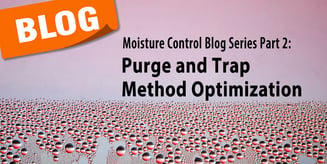
In part one of this series, we learned why water vapor is bad for volatile organic compound (VOC) analysis. In part two, we will explore ways we can optimize moisture control in the Purge and Trap (P&T) system.
Teledyne Tekmar has focused a large amount of effort on improvements to our moisture control by creating an improved moisture control fitting on the Atomx XYZ and the Lumin. Through this Moisture Control System (MCS) and application control, we can optimize our methods to help reduce moisture in the system.
The MCS allows water in the sample gas to be condensed and then removed prior to introduction to the Gas Chromatograph (GC) column. This innovation improves water vapor removal by as much as 60 percent over previous models. It can reduce peak interference caused by water vapor and increases analyte sensitivity and GC column lifespan, which can extend routine maintenance intervals.
For application control, you primarily want to make sure you’re using the correct analytical trap for the method being run. The trap is responsible for retaining the VOCs during the purge cycle and then quickly releasing them to the GC upon heating. While most standard methods define both the dimensions of the trap and the recommended packing materials, there are multiple packing choices that can be substituted, as long as they meet the analytical requirements of the method. You want a trap that is going to desorb your entire compound list. Therefore, we typically recommend a 3-bed adsorbent trap, like the #9 trap, shipped with all of our P&T, for general-purpose applications such as US EPA 524 series, 8260, or 624.
The next method parameter we would want to check would be the sample purge temperature. An increase in sample purge temperature increases the purge efficiency with which VOCs move from the liquid to the gas phase. However, there is a tradeoff: the amount of water vapor that makes it onto the analytical trap doubles for each 10 °C rise in sample purge temperature. We don’t necessarily want to go for the highest temperature the method or the sparge vessel heater allows, because of that increased water vapor onto the trap. In our experiments, as the sample purge temperature increases, we do not see as large an increase in purge efficiency. Therefore, the amount of water being put onto the analytical trap isn’t worth the additional analyte recovery. Experimenting with a range of sample purge temperatures could lead to you finding that sweet spot for your compounds of interest.
Another way to control moisture is through dry purge. Dry purge is a flow of clean, dry gas through the analytical trap just before desorption, to remove moisture. Typically, the larger volume of dry purge gas put through the system with a high flow rate, or the longer we dry purge, the more moisture we are going to remove. The tradeoff here is that if the dry purge is too long or if we use too much gas, it can also remove the lighter, more volatile compounds of interest from the trap. With the help of Tekmar’s MCS, the moisture management is so efficient that we can reduce the amount of dry purge needed. With the #9 trap, 30 seconds of dry purge should be sufficient enough for US EPA methods. If you’re having moisture control issues with your compound list, experimenting with a range of dry purge settings, both time and flow rate, is suggested.
This is a four part series discussing moisture control. Up next in this blog series, we will explore desorb and bake settings that can optimize moisture control in the P&T.
Teledyne Tekmar is always looking to hire qualified chemists. To see a current list of job openings visit http://www.teledynecareers.com/
